

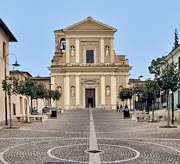
According to tradition, a church dedicated to St Valentine was built inapparently built on the site of his grave here after his death in 347 AD. According to Mario Pagano (referenced below):
-
“.. the semicircular ‘confessione’ in the tribune [of the present church], behind the altar, appears to be part of the apse of [this putative] paleochristian church. Recent investigation using ground-penetrating radar seems to confirm this hypothesis, and suggests [an early] basilica with three naves divided by columns” (my translation).
The was presumably the church that was documented for the first time in the ‘Liber Ponificalis’, which records that Pope Zacharias met King Liutprand in 742 “ad basilicam beati Valentini episcopi et martyris sitam in praedicta Teramnensium urbe ducatus Spolitini” (near the basilica of the Blessed Valentine, bishop and martyr, in ... Terni, a city of the Duchy of Spoleto).
The church was documented as part of the monasterium Sancti Valentini in the diocese of Narni in the middle of the 9th century. When Terni regained diocesan status in 1218, the church was contested between Terni and Narni. Pope Alexander IV confirmed the ownership of Terni in 1258 but required that the defences that had been erected around the church should be dismantled.
In 1573, Bishop Pietro Camiaino of Arezzo, the apostolic visitor, found the church to be largely ruined, although a small part of it was still in use. Little by way of restoration seems to have been achieved in the following three decades.
In 1605, Pope Paul V allowed Bishop Giovanni Antonio Onorati to search for the relics of St Valentine on the site. A decapitated skeleton was duly found and placed in the Duomo because the basilica was still in ruins. The papal authorities insisted that the basilica should be restored, in order that the relics could be returned there. They also proposed that it should be placed in the care of a community of Discalced Carmelites. Paul V ratified these arrangements in 1606, the new church was consecrated in 1609, and the relics were translated from the Duomo in 1618. It seems that they were initially placed in the crypt under the presbytery.
Father Domenico di Gesù e Maria, the general of the discalced Carmelites, was close to the Emperor Ferdinand II and played an important part in the programme to establish reformed religious orders Austria after the defeat of Calvinism. The Archduke Leopold Wilhelm of Austria, the brother of the emperor, visited Terni in 1625. He paid for the construction of an enlarged tribune at San Valentino in order to create a more fitting location for the relics. This project was undertaken in 1626-30, alongside a change in the nave, in which the side aisles were transformed into a series of inter-connected chapels. Cardinal Francesco Angelo Rapaccioli consecrated the church in 1649, and the Carmelite friar, Lucas de la Haye was commissioned to paint a number of altarpieces soon after (see below).
The relics of San Valentino were translated to their current position under the high altar in 1696.
The Franciscan friars from Santa Maria delle Grazie moved here in in 1798-9, when the French authorities requisitioned their convent for use as a military hospital.
The Carmelites were forced to leave the convent in 1860, but returned in 1906. The church was restored in the 1920s.
Exterior
The façade (18th century) was restored in 1854, and the statues in niches date to this period.
Interior
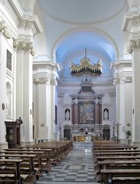
The church has a single nave with side chapels and two large transept chapels.
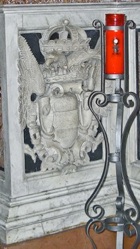

Crucifix (date?)
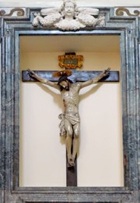
St Michael crushes demons (ca. 1630)
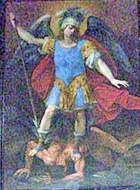
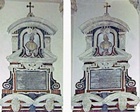
-
✴Ludovico Sciamanna, on the left; and
-
✴Bishop Brunoro Sciamanna of Caserta (died 1647), on the right.
Madonna and Child with saints (1635)

Panels (ca. 1650) by Lucas de la Haye
These panels by Luca di San Carlo da Nivélles, called Lucas de la Haye include:
-
✴St Valentine secures the Virgin’s protection of Terni, on the high altar;
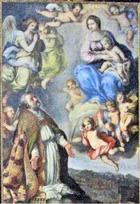
-
✴the Adoration of the Shepherds, on the left wall of the presbytery;
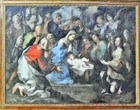
-
✴the Adoration of the Magi, on the right wall of the presbytery;

-
✴the Madonna and Child with SS Joseph and Teresa of Avila, in the Cappella di Santa Teresa d’ Avila in the left transept; and
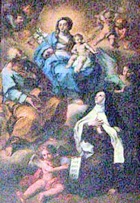
-
✴SS Saturninus, Castulus, Magnus and Lucius, fellow-martyrs of St Valentine, in small square panels high up in the nave.
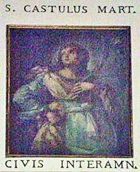
Crypt
Stairs in the left transept lead down to the crypt, which preserves the cranium of St Valentine and the presumed relics of SS Proculus, Ephebus and Apollonius, who were executed for having recovered St Valentine’s body after his execution in Rome. It also houses archaeological finds from the excavations under the basilica.
The restoration of the crypt was nearing completion when I visited in May 2010, and should soon be open for visits.
Marble relief (8th century)
This fragment of a peacock (the symbol of eternal life) on a column with a fish inscribed with a Cross (the symbol of the crucified Christ) is in the crypt.
Finds from the Site
Two sarcophagi and a number of funerary inscriptions that were found herein the 17th century suggest that a Christian cemetery developed around the grave of St Valentine.
Paleo-Christian sarcophagus (4th century AD)
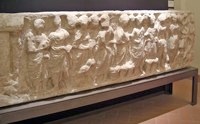
This sarcophagus in the Museo Archeologico has reliefs of scenes from the Old and New Testaments:
-
✴the raising of Lazarus;
-
✴a miracle of Jesus;
-
✴the multiplication of the loaves and fishes;
-
✴Adam and Eve; and
-
✴the sacrifice of Isaac.
According to Mario Pagano (referenced below):
-
“[This] lovely sarcophagus from the first half of the 4th century ..., [which was] divided into two compartments, evidently for relics, ... must have housed the bones of [St Valentine] and served as the altar of [a putative basilica built on the site of his grave]. ... all the heads [of the figures in its reliefs] were deliberately and carefully chiseled, [presumably] at the time of the iconoclastic decrees (ca. 727-40) of the Emperor Leo III ...” (my translation).
Christian Funerary Inscriptions (4th - 6th centuries AD)
Gianfranco Binazzi (referenced below) documented a number of these: those that could be dated ranged from 366 AD (his entry 17, p. 35, now lost) to 526 (his entry 28, pp 46-7, also lost). The following are catalogued in Coarelli and Sisani (referenced below) - are they exhibited in the Museo Archeologico ??:
-
✴The inscription (CIL XI 4329), which commemorates Nervinia Euresia, was commissioned by her husband Crispinus and their daughter, Umbricia Abundantia. It was dated “post consulatum Arcadi et Bautoni”: i.e. in the year after 385 AD, the year of the consulship of Flavius Arcadius (who became emperor in 395) and Flavius Bauto: it seems to be the oldest dated inscription from the cemetery that survives. [Entry 152, p. 150]
-
✴Two inscriptions from the cemetery commemorate bishops:
-
•The earlier of these (CIL XI 4340) reads:

-
....v(ir) (enerabilis) Homobonus epsic(opus) qui s[edit]
-
[annos ...], mensis VII, dies XXVIII i[n pace]
-
It commemorates Bishop Homobonus and date to ca. 400. [Entry 147, p. 147]
-
•The second of these inscriptions (CIL XI 4337) dedicated to the sacred memory of “Bonus”, who died at the age of 55 and who might well have been another bishop. It is dated to the consulship of “Senatore”: this was probably Cassiodorus (Flavius Magnus Aurelius Cassiodorus Senator), who was sole consul in 514 AD. [Entry 148, p. 148]
Read more:
M. Pagano, “Cimitero e Chiesa di San Valentino”, in”
A. Bravi (Ed.), “Aurea Umbria: Una Regione dell’ Impero nell’ Era di Costantino”, Bollettino per i Beni Culturali dell’ Umbria, (2012) p. 263
F. Coarelli and S. Sisani, “Museo Comunale di Terni. Raccolta Archeologica: Sezione Romana” (2008) Milan
Return to Monuments in Terni.
Return to the detour to Walk I.

